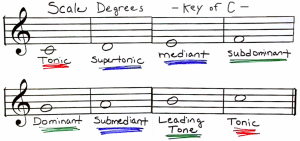SUMMARY
Write your daily summary last, at the end of the day here… Only one to two sentences.
CLASSROOM
Watch How Melody Works (47 minutes)
Melody is a sequence of notes that is musically satisficing. Every style of music is connected with the basic musical tetchiness. Melody is the most powerful tool to touch on emotions. A good melody is effective because of the universal musical tools. Every music system uses the same five notes. In the west, these notes are called pentatonic (the universal rhythm). Pentatonic notes are the black notes on a piano. “It’s not how many notes you have, it’s what you do with them”. A good melody depends on the notes you chose (frequency), the pitch of the notes, and the distance (intervals) of the notes. The smallest distance is a semitone (on a piano, it’s the key right next to the first key played). When music was created, it started with the human voice, and whole tones. Even though other cultures had different folk songs, they all mainly used whole tones. When people started to become more experiential, jumping to the third became more popular. Scales gave composers a basic structure or concepts. Different scales give different emotions or “flavor”. Europe got its scales (or modes) from the ancient Greeks. After the 16th century, musicians started to sharpen and modify the scales when they went up the scale and flattened the notes when they went downward. When the runs were played at the same time and clashed, they were called fault inversions. Blue notes (played in the blues) are when you flatten or “sagged down” some of the notes. in classical music (Shakespearean or Elizabethan) the musicians needed to agree to be able to play together. they took parts of old modes and tutors and smooched them together. this created the new minor scale. Scales became more flexible and could start on any note. The new major and minor scales were created to be compatible with each other. This was called the diatonic system. after about a hundred years, Europe started to play with folk music again. In the twentieth century, American music had some inspiration from indigenous folk music. migrations of nonconformist religious groups brought their music to the states. This brought out much happier music. At the end of the nineteenth century, Jewish melody became a big part of American music. All the modern music today is built on musical roots.
LAB
I found out that I really like HookTheory. its simple and it doesn’t need any special (expensive) equipment. the hardest part of using this site is the keyboard. you have to understand what key does what. even though its hard, all I need to understand it better is more practice and experience.
OUTSIDE / JOURNAL / IDEAS
“Aren’t you afraid your never going to top that”? “Aren’t you afraid your never going to get success”? “yes…im afraid of all those things…its likely that my greatest success is behind me”. How do we brush agent it without losing our minds, but to keep us sane? “Don’t be afraid, don’t be daunted, just continue doing your job”- Elizabeth Gilbert
Scenius-creative intelligence of a community
STUDIO
- By Jamie Henke, music.wisc.edu/faculty/jamie-henke/
- As you watch Jamie Henke define and explain melody terms, YOU write them below…
- (hint: if the definition appears on the screen, pause and write it down)
“To study music we must learn the rules. to create music we must forget them.” -Nadia Boulanger
Melody Composition Terms
- Theme ~ long rhythmic idea
- Motive ~ short rhythmic idea
- Period ~ 8 measures, standard length of melody
- Phrase ~ 2 sets of four measures
- Antecedent (Question) Phrase ~ starts sentence
- Consequent (Answer) Phrase ~ finishes sentence
- Scale Degrees
- Tonic ~begins and ends scale (determines key and relation)
- Supertonic, Mediant, Submediant ~ moderate level force
- Dominant, Subdominant, Leading Tone ~ most forward moving force, most tension
- Steps ~ any movement using half or whole steps
- Leaps ~ any movement not using half or whole steps
- Conjunct motion ~ smooth movement
- Disjunct motion ~ not smooth movement
- Repetition ~ used repeated material to link two phrases together
- Contrast ~ material that contrasts a phrase
- Variation ~ half way between repetition and contrast
Melody Resources


Mr. Le Duc’s Key of C Major Notes and Chords Chart (PDF)
CONTROL ROOM
Learn how to Create Tracks
Explore the Piano Roll, Drawing and Moving Notes
Learn to Edit Notes, Velocity, and More
Learn to Create Your Own Presets
- Write a brief reflection on how this process worked for you.
WHAT I LEARNED and PROBLEMS I SOLVED
Tell your daily story here! Highlight what you learned and enjoyed most. Problem-solving is one of the most important skills you need in life. Employers want to know HOW you get stuff done as much as WHAT you got done.